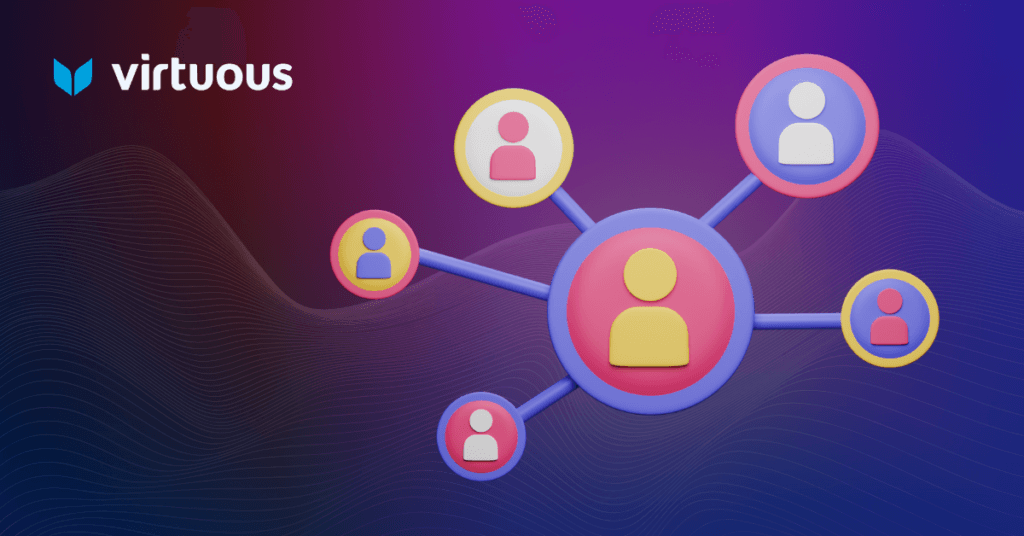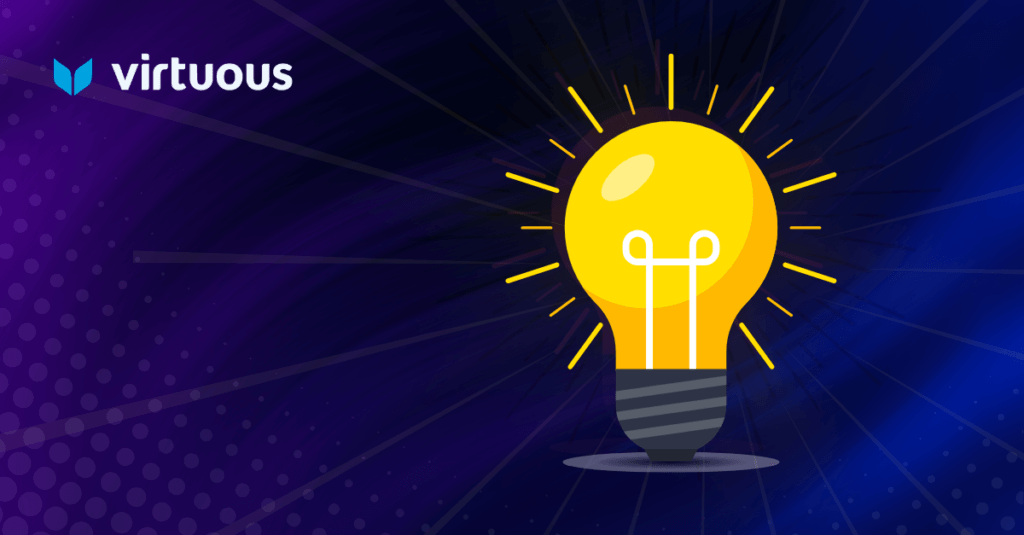The long-term value of a donor is a critical metric that often doesn’t get the attention it deserves. The key to sustainable nonprofit growth lies in the average donor retention rate—a figure that tells us more about the health of our fundraising efforts than any single large donation ever could.
While the allure of new donors is undeniable, it’s the ongoing support of repeat donors that truly forms the backbone of any nonprofit’s financial stability. Industry insights reveal a stark truth: the cost of acquiring a new donor far outweighs the expense of keeping an existing one, with a break-even point that can stretch to a daunting 18 to 24 months. By shifting our focus to strategies that bolster average donor retention, we’re not just saving on acquisition costs—we’re building a foundation of loyal supporters who will fuel our mission for years to come.
Donor retention is not only the more cost-effective strategy—it’s the one that turns a casual donor into a long-term supporter. Hear us out:
The donors in your file have previously given to your nonprofit. This means they already have a vested interest in your cause and have a potential intent to give again—you just have to figure out how to unlock that returning generosity.
The point isn’t to encourage you to choose between donor acquisition and retention. Both are essential strategies to keep in your digital fundraising game plan—but don’t choose acquisition over retention if you have a high donor churn rate. If you’re struggling with a high churn rate, review your retention efforts to see what is going awry.
Now, deciphering the complexities of what truly works in a donor retention strategy might seem daunting, especially since what works well for one organization might not work as well for yours. But don’t fret just yet—there’s a silver lining! The key to understanding what tactics will work for your organization and get you better average donor retention is within grasp. It’s about listening to the experts themselves (your donors) and combining that feedback with the evidence at your fingertips (your data).
But first, we’ll take a deep dive into what the data is telling us about nonprofits’ average donor retention.
The Truth About Average Donor Retention
The nonprofit sector is facing a donor retention problem, and industry data tells us that average donor retention rates are consistently lagging. Research from M+R reveals that the online donor retention rate for new donors was 29%. Additionally, 2022 data from the Fundraising Effectiveness Project shows an even lower new donor retention rate at 19.1%. These statistics, coupled with the fact that this rate has yet to return to pre-COVID levels, underscore the persistence of low retention rates.
A striking revelation from the M+R benchmarks report—only 16% of new online donors are anticipated to contribute again in the subsequent year. Focusing on online donor acquisition is important, but such a small percentage of donors paints a bleak picture of the challenges faced in building a sustainable program. The effort, resources, and investments poured into acquiring first-time donors often yield meager results in terms of long-term commitment.
“Only 16% of your new online donors are going to give to you again next year. All the time and energy and money that you invest to acquire all these new donors, only 16% are going to stick around. The odds of building a program that’s sustainable based on those retention rates? That’s so hard. That’s nearly unsustainable.”
Nathan Hill, VP of NextAfter, explained at the recent Responsive Nonprofit Summit.
Looking at historical data, the struggle to retain current donor bases dates back years. A 2005 data snapshot from the Fundraising Effectiveness Project revealed a distressing reality: For every 100 donors acquired, a staggering 82 were lost. With retention rates continuing to decline, there’s an urgent need to prevent how many lapsed donors are sitting in your donor database.
What Does Online Donor Behavior Have to Do With Donor Retention?
Digital engagement is at the forefront of fundraising efforts for many organizations, so before launching any new strategies to increase your average donor retention, here is something to consider: does online donor activity have any relation to a high average donor retention rate?
To better understand online donor behavior and retention, we partnered with NextAfter to do a deep dive into research around online donor retention. While the report offers a comprehensive understanding of online retention, there are three data points to note as they relate to donor behavior.
A Strong Need to Expand Recurring Giving Programs
It is no surprise that recurring giving is a surefire way to boost your average donor retention rate. After all, if you have a donor who is giving on an ongoing basis, you’re automatically retaining that donor month after month. That means the more regular donors you have, the higher your average donor retention rate.
Our research on recurring donors is consistent with this antidote—the highest-performing organizations in donor retention also have the highest number of recurring donors.
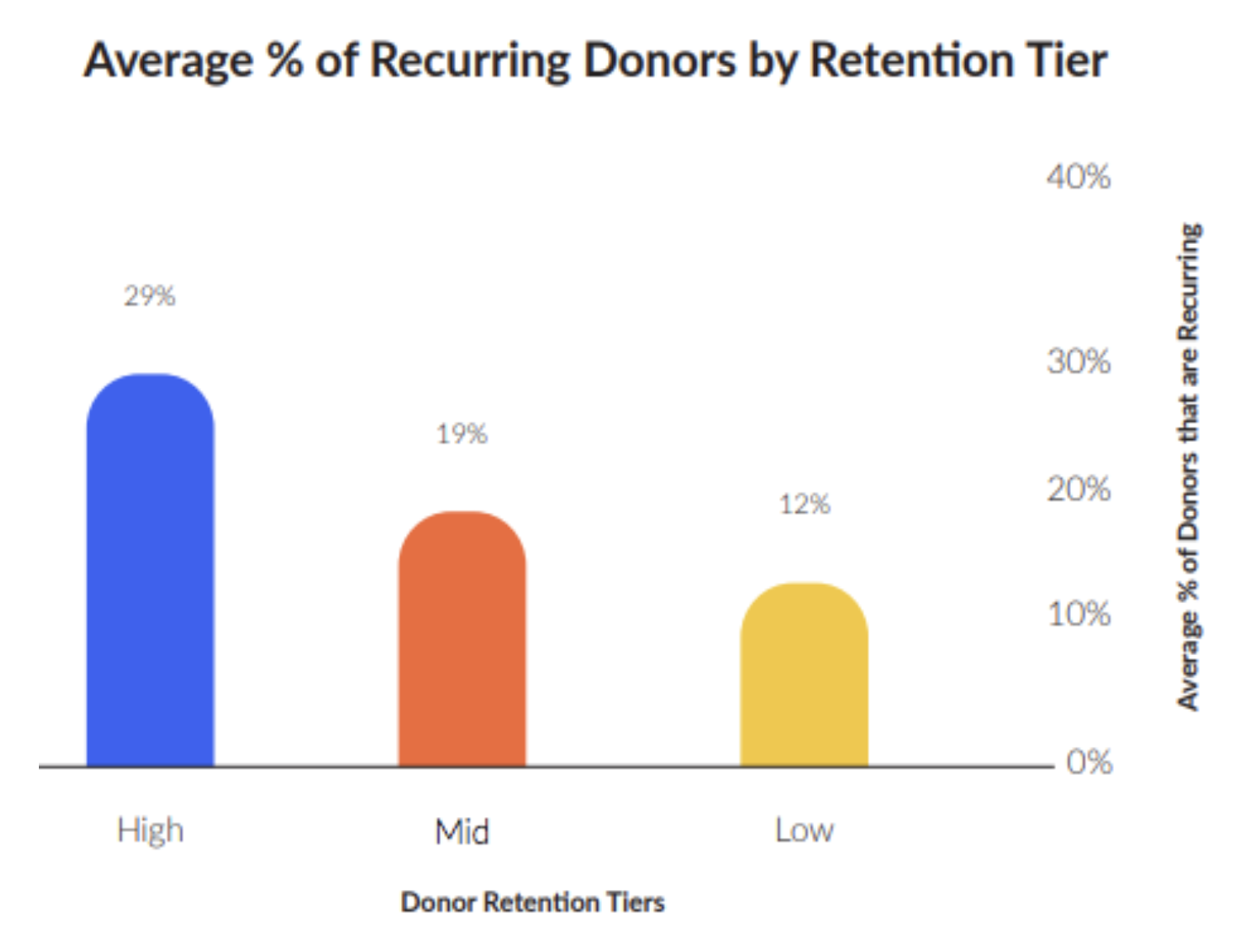
The most obvious takeaway from this data is that organizations must have a way for donors to give online via a form that has an option for making the gift recurring. Building relationships and talking to donors is essential, but if you don’t have that simple functionality on your online giving form, you are leaving generosity on the table.
Slight Variance in Increased Website Traffic on Donor Retention
One of the questions we sought to answer was whether or not increased website traffic had a significant impact on average donor retention. We found that the average low-traffic organization has a 55% retention rate, and the average high-traffic organization has a 45% retention rate. However, this trend was inconclusive as we found high and poor performers at every level of size and sophistication.
So the real question is, “Is high-performing donor retention a function of the size, sophistication, and resources of a nonprofit?” And our answer is a resounding no. Anyone can have high donor retention—so there’s an opportunity for everyone to succeed.
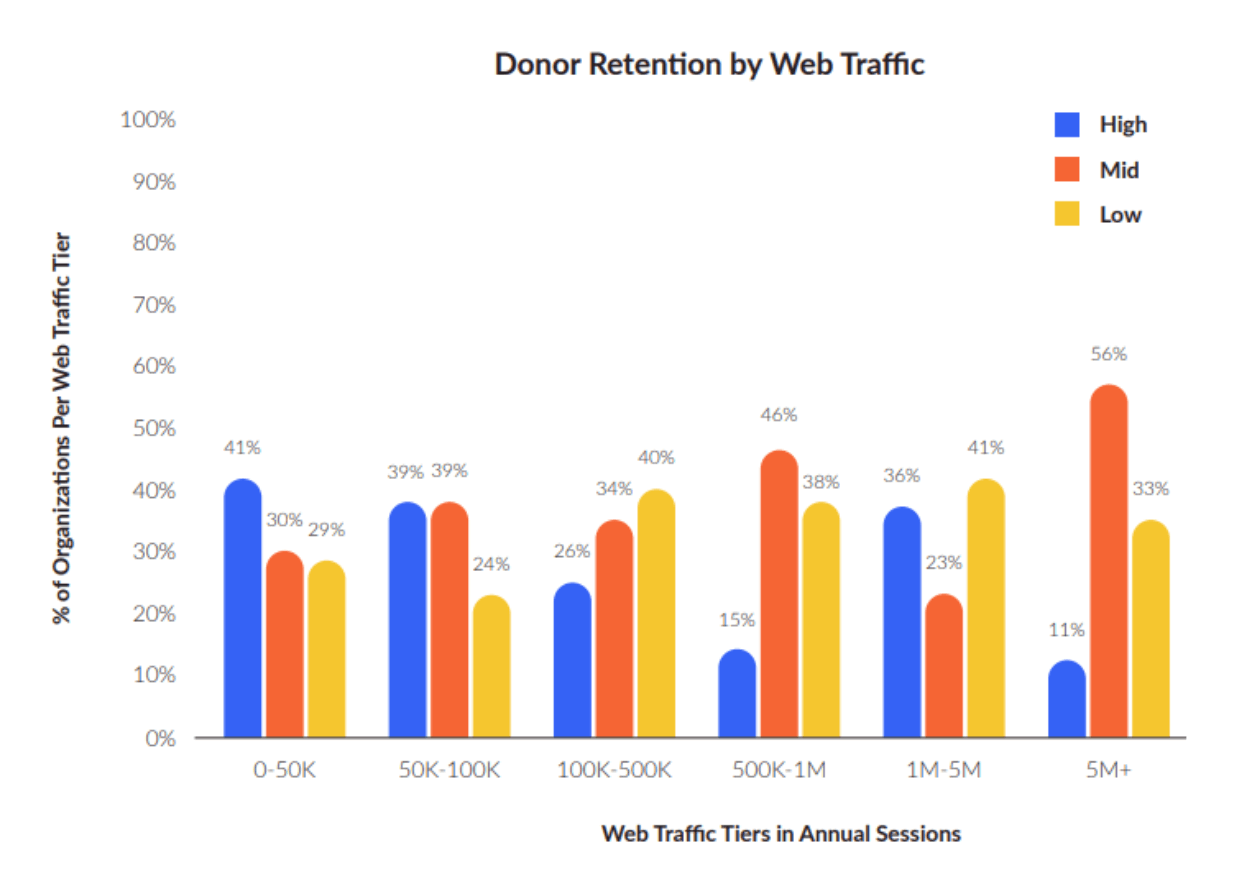
Clarity in Donation Pathway May Have Minimal Impact on Donor Retention
Ensuring that potential donors have a clear end-to-end journey from the moment they land on your website to when they finalize their donation is crucial. A straightforward and intuitive online donation process not only reduces barriers but also enhances the probability of a visitor becoming a committed donor. But does having clarity in the donation process impact your average donor retention rate?
The simple answer is no. A well-defined and accessible donation page is undoubtedly beneficial for encouraging initial donations, but it doesn’t necessarily translate to retaining donors over time. Our research has shown that organizations with the clearest donation processes often only achieve moderate success in retaining donors.
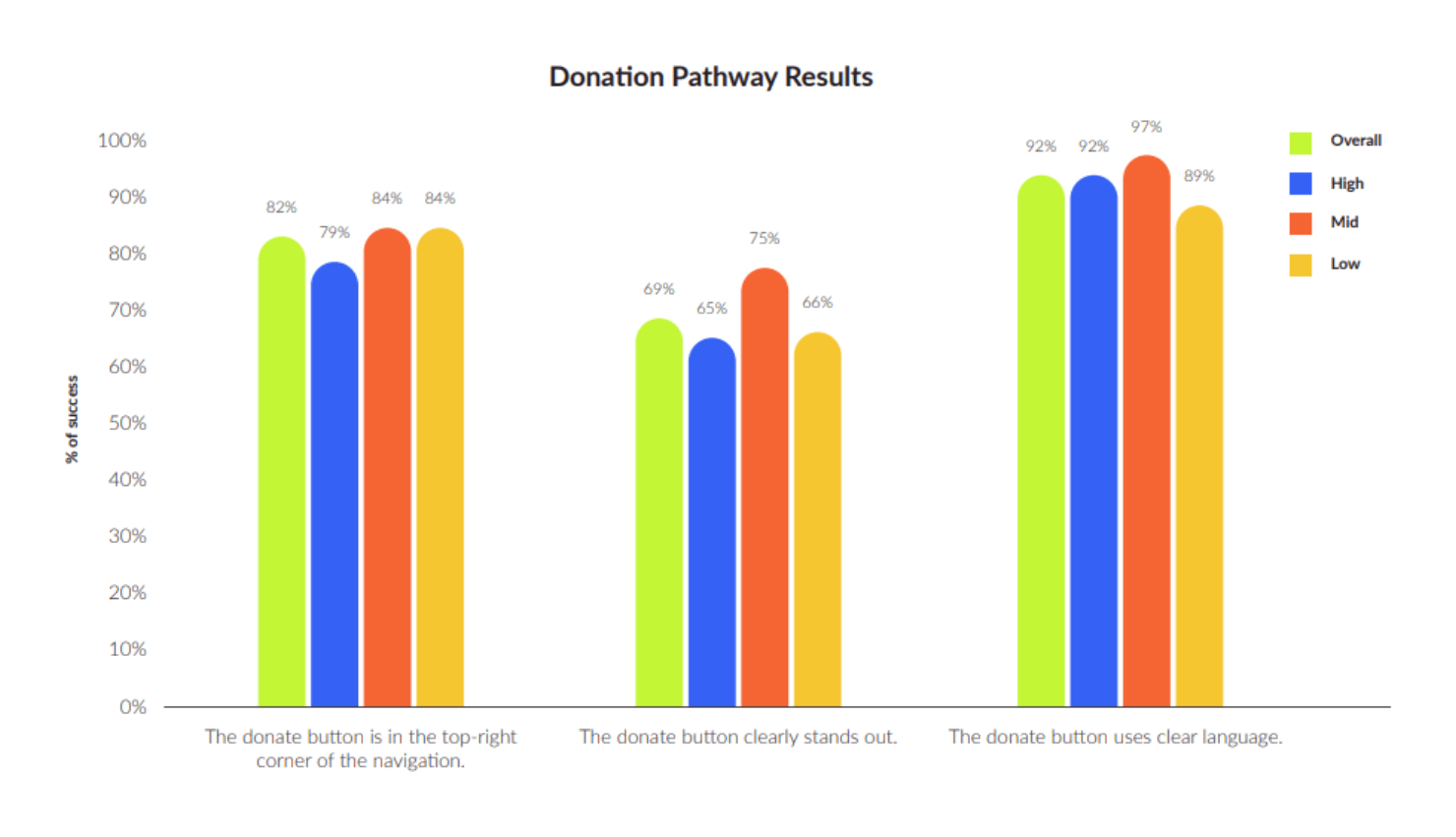
In an experiment, we tested the clarity and design of an organization’s (The Gospel Coalition) donate button. In the control version, the “Give” button was on the right side of the navigation with what we call a “ghost button design”—meaning it blended in with the rest of the navigation buttons.
On the other hand, we tested the control version against our treatment, which included changing the button text to “Donate to TGC” and making the button stand out from the rest of the navigation by changing it to a green color.
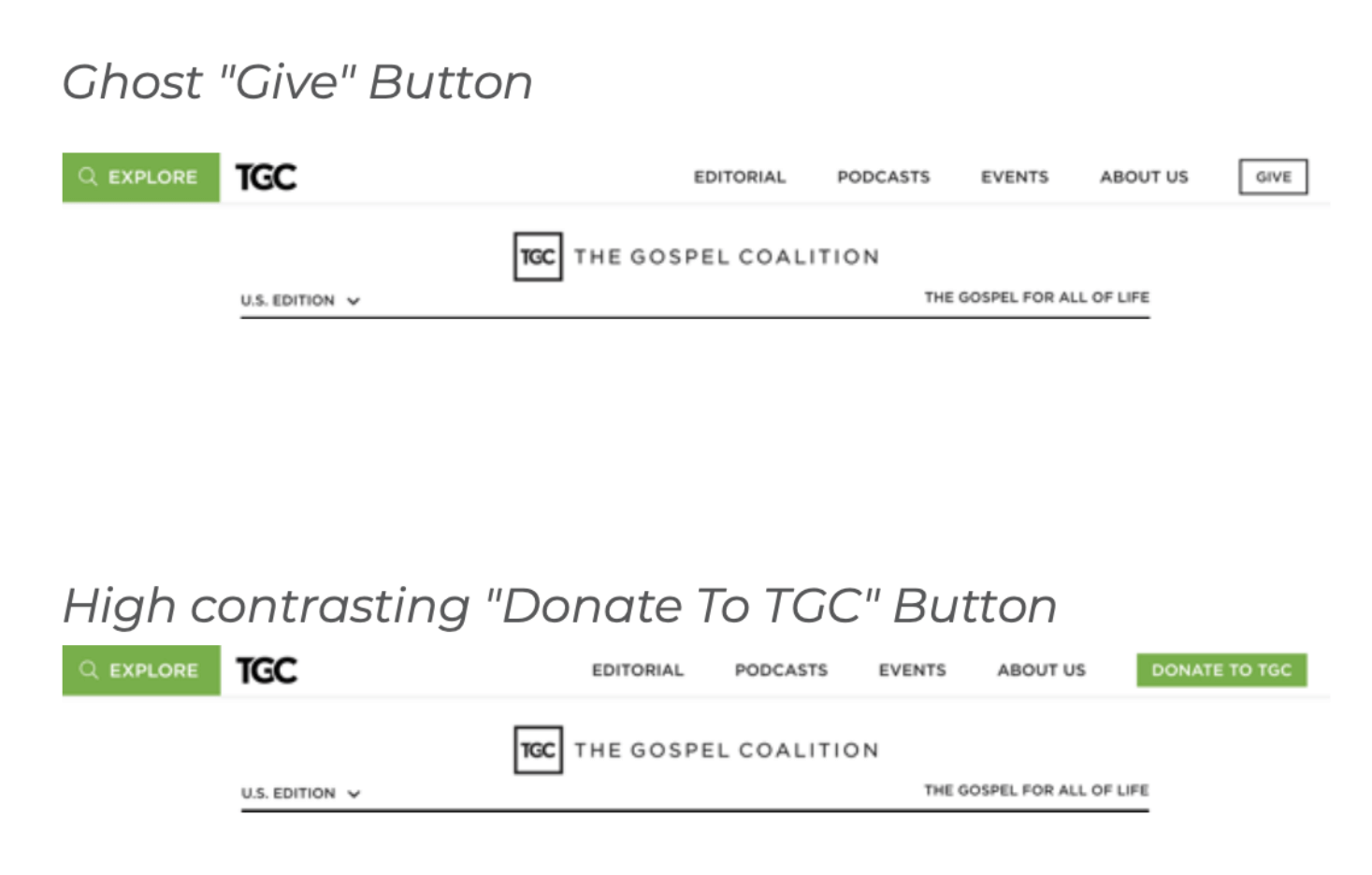
The change in text and button color resulted in a 28% increase in clicks to the donation page. This shows you that while the clarity in the donation pathway may not be directly tied to better donor retention, a lack of clarity could prevent someone from donating at all.
3 Ways Data Can Inform How You Engage Donors
In today’s digital-driven environment, it’s no longer a luxury to have a good nonprofit CRM in place—it’s a necessity for every nonprofit. A well-performing CRM can capture donor behavior and activity, giving your team a comprehensive view of how your donors are responding to your fundraising campaigns.
Harnessing the power of data in your CRM, coupled with genuinely listening to what your donors are telling you, is the key to unlocking insights into which retention tactics resonate with their donors. Rather than relying solely on assumptions, attaining better donor retention metrics and cultivating stronger donor relationships involves actively listening to the voices of those who fuel nonprofit missions.
Let’s talk about three ways your team can make informed decisions based on data you already have on hand.
1. Discover Unique Insights About Your Donors
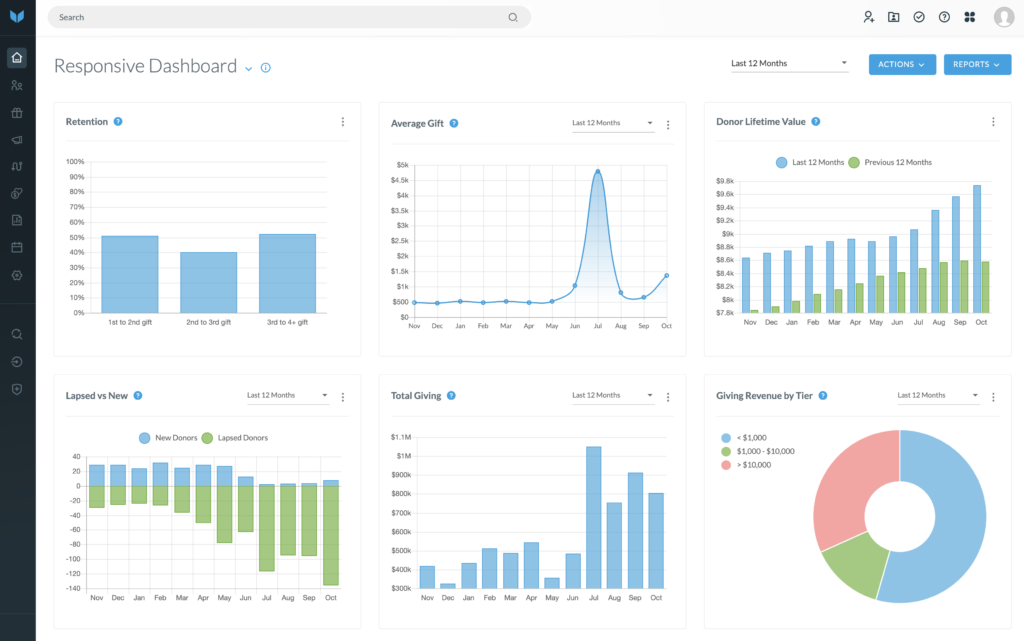
The technology that exists today takes the guesswork out of planning your retention strategy. With a responsive nonprofit CRM like Virtuous, your organization can create an easy-to-navigate dashboard that includes key data points like a giving overview, web history, volunteer activity, and social insights—all in one personalized view. Having all of this relevant data at your fingertips keeps your team close to the pulse of donor behavior. It empowers you to craft responsive campaigns that pinpoint the needs and preferences of your donors.
If you’re looking to find more engaging ways to cultivate and steward donors to become repeat supporters—through activities like donating, volunteering, or advocacy—the best way to start is by analyzing what the average donor journey looks like.
Here are some questions to think about right off the bat:
- Are they lapsing after one donation? The donor may have forgotten about your organization because they were never reminded to give again. You might want to see if you’re doing your part by following up after the initial thank-you email. It could make all the difference.
- Did they cancel their recurring donations? It would be best if you looked into why they canceled in the first place. This extra step gives your organization the information it needs to keep that donor on file. For example, if they are going through a financial hardship, provide them with the option of freezing their donation for a certain amount of time or lowering their recurring gift.
- Has their credit card information expired? Don’t let an expired credit card keep you from receiving your recurring donations! The donor most likely won’t remember to update their credit card information, so it would behoove you to have a system in place that reminds donors before this happens (more on this below).
- Do they only give one larger gift once a year? Consider launching a recurring giving campaign that targets these annual donors to ask if they want to break their donations into smaller amounts throughout the year. For instance, if they are giving a $500 donation at the end of the year, why not suggest giving monthly installments of $50? Spoiler alert: That would be a 20% lift in donor lifetime value.
Why not find some time in the near future to do a quick audit to address the above points mentioned above? You might find that making these tweaks could result in a pretty immediate average donor retention rate increase.
2. Build Stronger Donor Relationships With a Personalized Donor Journey
Your donors want authentic communications with your nonprofit. If a donor has already given to your organization, you know that your mission is meaningful to them—but today’s modern donor needs more than a worthy cause. Remember, your donors are also consumers who are getting hyper-personalized experiences with their favorite brands—think about how Netflix recommends movies you may like or how Amazon triggers product recommendations.
A generic appeal or thank-you email with the donor’s first name filled into the salutation just isn’t as effective anymore, and it’s certainly not going to move the needle much in building a stronger relationship with them. Good retention efforts mean you have to take your marketing omnichannel. Virtuous understands the value of a personalized and responsive donor journey. That’s why we have built an entire marketing toolkit that enables you to engage with donors across every channel in a very dynamic way.
The team at Norwescap is a prime example of how taking a more tailored approach to marketing communications has made all the difference for their organization. With a robust digital outreach strategy and a deeper understanding of analytics, Norwescap can now follow up with donors who have not yet fulfilled the ask, increasing their odds of converting a gift.
“It really became one comprehensive campaign and because it was all being managed and tracked through Virtuous, we were able to see every step of the way. We can now answer questions like ‘What’s happening?’, and ‘How are our owners responding?’ ‘How are they interacting?’ ‘How are they behaving?’ And that allowed us to get very refined with our communication.”
Heather Thompson, Chief Development Officer of Norwescap
3. Scale Your Marketing Efforts With Automation Workflows
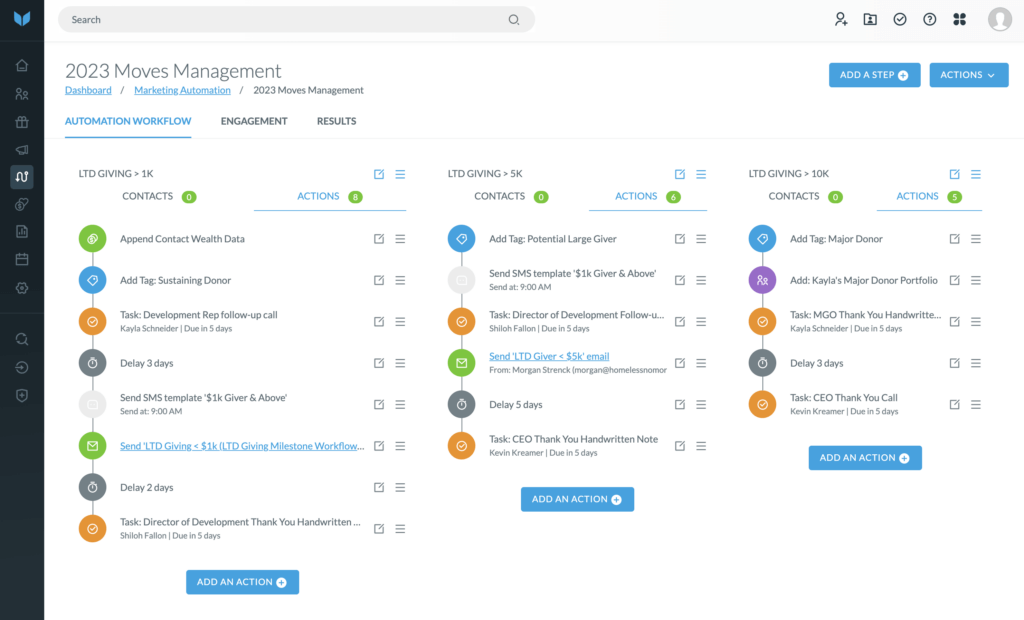
As nonprofits manage with limited time and budgets, finding additional resources to further strengthen donor relationships might seem like a big ask. However, it doesn’t have to be. This is where your team can use automation to accomplish more manual tasks, like sending emails and updating custom tags, while your team focuses on relationship-building tasks, like calling donors.
With the help of modern fundraising platforms like Virtuous, organizations can use the data that have on file to segment donors into groups based on preferences, interests, or activity and create targeted campaigns and automation workflows for each group. Additionally, your team can schedule timely follow-up emails based on specific triggers or actions, such as donation confirmations, event registrations, or milestones.
Through automation, you’re taking the burden off of your staff but also maintaining a consistent flow of communication with your donors. Good automation can help you take your major gifts cultivation strategy and empower you to provide that same level of care to every donor. This fosters trust between your organization and its donors, ultimately helping you build strong relationships and see your current donor retention rate improve.
The Ultimate Guide To Nonprofit Marketing Automation
This guide to nonprofit marketing automation will walk you through how powerful automation can help you generate more generosity while reducing manual work.
A Deep Dive Into Donor Retention Trends
Want to learn how to take your donor retention strategies to the next level? Virtuous recently partnered up with the fundraising experts at DickersonBakker to dive even deeper on how nonprofit leaders can level up their donor retention strategies.

